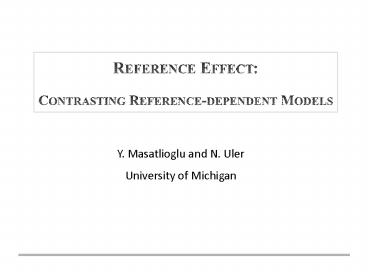Public Goods Provision in Egalitarian Societies - PowerPoint PPT Presentation
Title:
Public Goods Provision in Egalitarian Societies
Description:
If transactions costs are small enough, reference points should not ... Organ donation. Car insurance. Car purchase options. Consent to receive e-mail marketing ... – PowerPoint PPT presentation
Number of Views:55
Avg rating:3.0/5.0
Title: Public Goods Provision in Egalitarian Societies
1
Reference Effect Contrasting Reference-dependent
Models
Y. Masatlioglu and N. Uler University of Michigan
2
Do Reference Points Influence Economic Outcomes?
- Standard Neoclassical Theory
- If transactions costs are small enough,
reference points should not influence
rational consumers. - In practice, defaults make an enormous
difference - Organ donation
- Car insurance
- Car purchase options
- Consent to receive e-mail marketing
- Savings
- Asset allocation
3
Reference-Dependent Behavior
- Endowment Effect
- The gap between WTA and WTP
- Status Quo Bias
- People often stick with their default options
- Reference Effect
- Reference points alter one's choices even when
agents do not stick to the reference point itself
4
The Reference Effect
STATUS QUO BIAS x is more likely to be chosen
from the set x, y when x is the endowment,
REFERENCE EFFECT x is more likely to
be chosen from the set x, y, r when there is an
endowment, r.
Good 2
y
x
r
Good 1
5
Reference-Dependent Models
- Behavioral Models (Positive Approach)
- Tversky and Kahneman (1991)
- Rational Models (Normative Approach)
- Masatlioglu and Ok (2005, 2007, 2009)
6
Tversky and Kahneman (1991)(Loss Aversion Model
(LA))
- Reference dependence
- Loss aversion
- Diminishing sensitivity
concave for a gt 0, convex for a lt 0
7
Loss Aversion Model
8
Shortcomings of the LA model
- Non-convex Indifference Curves
- Unusual Cyclical Choices
- Accommodates not only Status Quo Bias but also
Status Quo Aversion
9
Unusual Preference Cycles
- Munro and Sugden (2003) show that one can
find three alternatives, x, y and z such that
10
Loss Aversion Model predicts Status Quo Aversion
- EXAMPLE Consider an environment in which
an agent needs to choose among pairs (x,m), where
x and m stand for the units of a private good and
money, respectively.
Choose between one mug and 100 and no mug and
103 when there is no reference
Now, status quo is one mug and 100 what would
you do?
STATUS QUO AVERSION !!!
11
Constant Loss Aversion (CLA)
- We say Constant Loss Aversion if there is no
diminishing sensitivity or constant sensitivity
(gi is linear). - While Loss Aversion Model
- permits non-convex indifference curves and
intransitive preferences - accommodates not only status quo bias but also
status quo aversion, - While Constant Loss Aversion does not suffer from
these implications, it is much more restrictive
than the LA model.
12
The Multi-criteria Choice ModelMasatlioglu and
Ok (2005)
Axiom of Status Quo Bias
- If y is chosen when x is the status quo point,
then, y must be chosen when y is itself the
status quo.
13
Masatlioglu and Ok, 2005 (The SQB Model)
Sports
Assume that r is the status quo
Acceptable alternatives when r is status quo
r2
r
U w1u1w2u2
Movie
r1
14
Loss Aversion vs. Status Quo Bias
- Loss Aversion Model
- Status Quo Bias Model
15
The Generalized SQB ModelMasatlioglu and Ok
(2009)
Mental Constraint
such that
16
The Procedural RD Model Masatlioglu and Ok (2007)
Another generalization of SQB model with two
mental constraints, Q1and Q2
such that
17
Some Facts about Experiment
- Conducted at C.E.S.S. (NYU)
- A total of 99 subjects
- Money and Chocolate
- Each subject answered 16 questions
- On average, earned 14 including the 7 show-up
fee and also some chocolates
18
Experimental Design
Belgium Chocolate
y
x
r1
r5
r3
r7
r2
r6
r4
r0
Money
19
A Screen Shot from the Experiment
20
Experimental Design Theoretical Predictions
Assume that y is preferred to x when there is no
reference point.
There are four possible cases
Good 2
y
x
r1
r2
r0
Good 1
21
Loss Aversion Model
Good 2
LA model favors x
y
x
r1
r2
Good 1
22
SQB Model
Good 2
y
SQB model favors y
x
r1
r2
Good 1
23
Generalized SQB Model
Good 2
y
GSQB model is indecisive
x
Q(r1)
r1
Q(r2)
r2
Good 1
24
Procedural R-D Model
Good 2
Q1(r1)
y
Q1(r2)
PRD model is also indecisive
x
Q2(r1)
r1
Q2(r2)
r2
Good 1
25
Theoretical Predictions for r1 r2
Belgium Chocolate
y
x
r1
r2
r0
Money
26
Theoretical Predictions
y
x
r1
r5
r3
r7
r2
r6
r4
r0
27
Reference Effect Preference Reversals
28
Comparison of the Models
Explanatory Power of the Models (in percentages)
29
Seltens Measure of Predictive Success
30
Conclusion
- Existence of the reference effect
- An experiment that distinguish between the models
of reference-dependence. - R-D Models make different predictions regarding
the reference effect. - We find that both the PRD and LA models explain
approximately 90 percent of the data.
31
THANK YOU
32
Comparison of the Models
Explanatory Power of the Models (in percentages)
33
Constant Loss Aversion Model(No Diminishing
Sensitivity)
Good 2
Indifference curves when r is the reference
point
r
Indifference curves when there is no reference
point
Good 1
34
(No Transcript)
35
Procedural R-D Model
Q1(r)
Q2(r)
r
36
The Generalized SQB Model
Good 2
Mental Constraint Set
r
Good 1
37
Comparison of Models
38
A Sample Question from the Experiment
39
Comparison of Models
40
- Assuming that he or she understands his or her
current plan, a reasonable strategy would be to
undertake a comparative analysis including only
some subset of competing plans (ignoring the
others altogether). - W. Samuelson and R. Zeckhauser, 1988
41
Is SQB Axiom too strong?
Take x CUNY, y OSU and z UM
OSU c(CUNY, OSU,CUNY) UM
c(OSU, UM,OSU) But CUNY c(CUNY, UM,CUNY)
42
Relaxing SQB Axiom?
Weak Status Quo Bias
implies
and
implies































